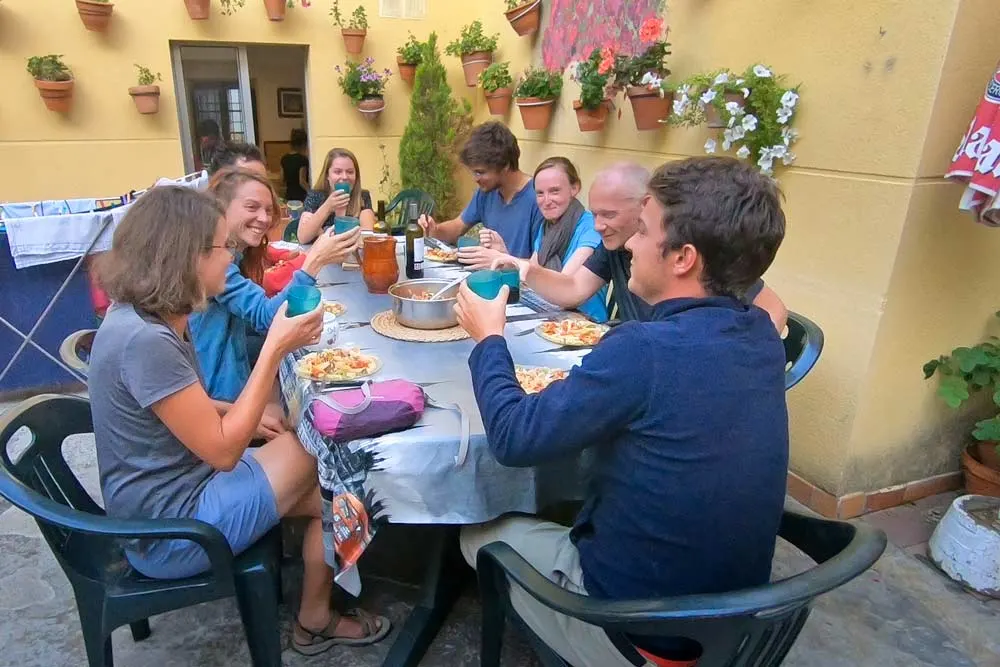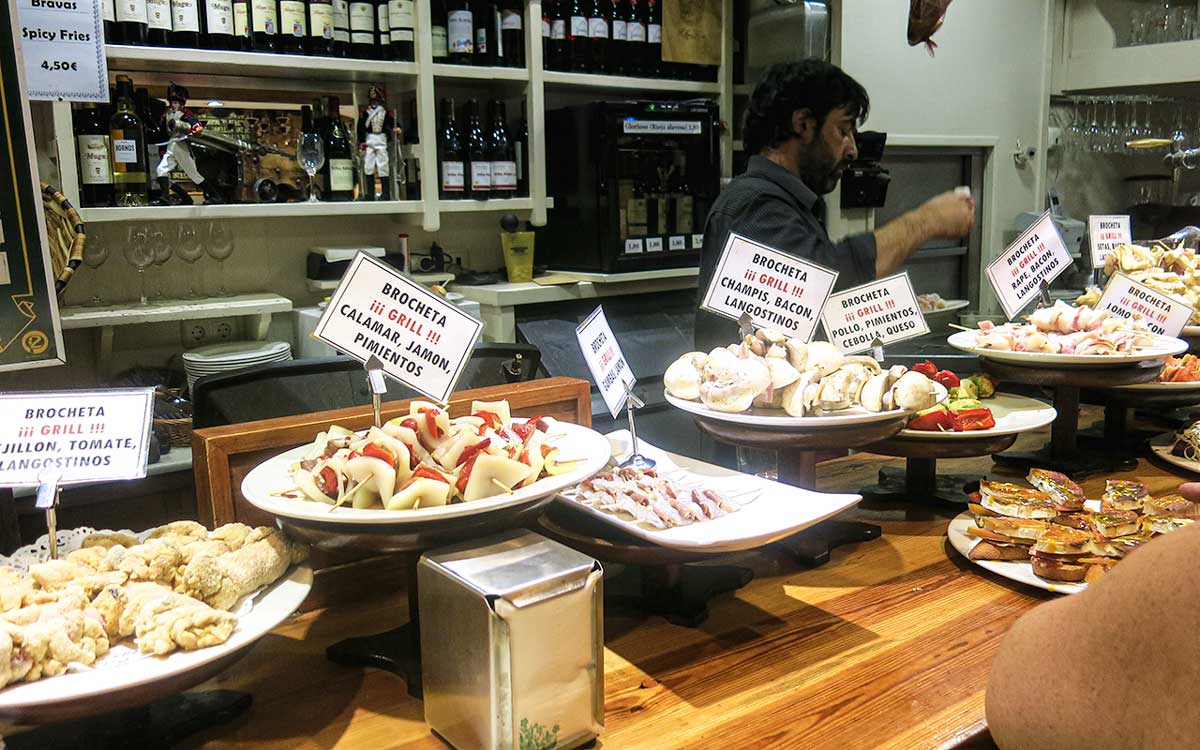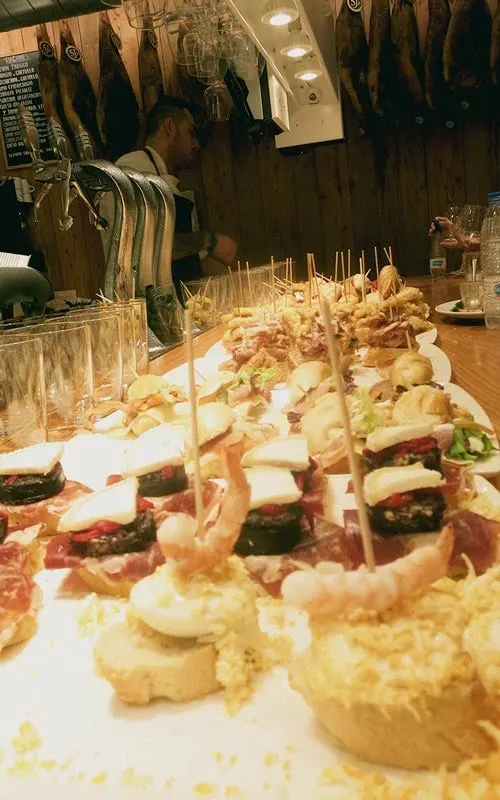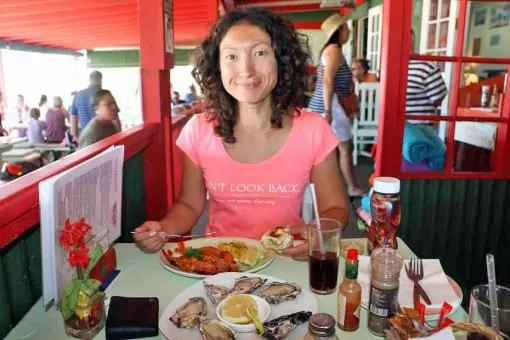Food is a big deal when walking the Camino de Santiago pilgrimage. The pilgrim menus are something to look forward to if you are planning to walk to Santiago de Compostela. Spanish food is great and burning a lot of calories walking all day will make you hungry! The Camino de Santiago is a network of routes. We were very privileged to walk nine different routes to Santiago de Compostela and enjoy great food on the Camino de Santiago in smaller towns and bigger cities on the Camino Francés, the Basque country, the Camino Portuguese, the Via de La Plata, and several other Camino routes.

Different Camino routes explore different regions, and many towns on the Camino have culinary highlights. Finding food is not a problem on the Camino with plenty of café, bars, restaurants, and grocery stores and a potential cup of coffee or glass of red wine encouraging you to walk to the next village. Don´t forget the opening hours of shops might differ from what you are used to, the Spanish love their siesta.
Everybody has their favorite Camino de Santiago food; tortilla de patatas (Spanish omelet), café con leche (coffee with milk), and menu del dia are the first things mentioned by pilgrims sharing their delicious food experiences.
In this Camino de Santiago food guide, I’ll share with you some food options while doing this long walk, some of the most traditional dishes not to miss on specific routes, and some money-saving tips. What you eat will have a massive impact on the cost of walking the Camino de Santiago.


To make your navigation on our site easier and quicker we have created the Camino de Santiago resource page. There you can find all our Camino posts divided into different topics.
Food on the Camino de Santiago – Guided Tours


Where do you Eat on the Way?
You will probably eat most of your meals at bars. The bars in Spain are open from early morning till late and serve drinks, pastries, food, and great coffee. It is sort of a social center point for citizens living in the area and people hang out here at all times of the day. We often do shopping and prepare our own meals in the Albergue kitchen. Some Albergues prepare communal meals for dinner, this is always fantastic and a great social event, a great place to meet other pilgrims.
Camino de Santiago Food – Breakfast on the Way
You will need a healthy meal to prepare you to walk at a good pace all day. Breakfast (desyuno) on the Camino is usually a light meal and most pilgrims make two stops. The majority of people start walking very early (between 5 am and 6 am) some even earlier. It is difficult to find an open bar that serves coffee and breakfast at this hour. Most pilgrims eat something light if the have an early breakfast. A tostada (Spanish toast) or a napolitanas de chocolate (chocolate croissant) are popular options.
I love Spanish tomato tostada for breakfast, a piece of toast with olive oil and tomato pulp drizzled over the top. Churros con chocolate is an excellent breakfast that is quite common in Spain. Churros is a crispy, fried-to-perfection dough stick, lightly dusted with sugar and then dipped in thick hot chocolate. A sweet, deep-fried dough treat with chocolate is a delicious breakfast, you are going to walk all day anyway. In bigger towns on the Camino keep an eye out for a traditional churrería where you can find this treat at a good price. In Santiago de Compostela, Chocolateria Metate is well known for serving excellent churros.


At about 10 am after walking the first 5 to 10 km, we stop for something a bit more filling, it does happen in small towns where nothing is open for early breakfast! My favorite breakfast food on the Camino de Santiago is a Spanish tortilla, the Spanish omelet is baked egg, potato, and sometimes with onion. Similar to a French Quiche without a crust.
Tortilla bocadillo is the Spanish omelet served on a bocadillo (baguette). It is becoming more common to see bars offering an ‘American breakfast’ with toast, fried eggs, and bacon. It is a good idea to just buy some fresh fruit the day before. Freshly squeezed orange juice, coffee or tea are available at most places
Coffee on the Camino de Santiago
We are caffeine junkies and I look for coffee before I think about food. Café con leche (coffee with milk) is legendary in Camino circles and many people fall in love with this delicious coffee. Like cappuccino and latte, it is microfoam milk and espresso, similar to a latte, but with a bit less milk. It has a bit more foam, so creamier than a standard latte. I drink my coffee black, and like the Americano in Spain, they add very little water. A cafe solo is an espresso.


Spanish Dishes for Lunch
Where and what you eat for lunch on the Camino will depend on your walking pace and the time you start walking. If you are still far from being done on a hot day, you will probably feel less like eating a set menu and drinking wine, than if you are finished walking for the day, and you have already kicked off your shoes.


We always eat a lot of bread on the Camino, I think that (and the wine and beer) is probably the main reason why pilgrims sometimes pick up weight even though they walk 20 to 30 kilometers per day! It is difficult to loose weight on this diet of Camino de Santiago food. A traditional Spanish bocadillo, is a sandwich served on a baguette. Usually a 6- to 8-inch long portion of baguette, sliced in half and filled with Spanish chorizo sausage, or tuna. Sandwich jamón y queso (ham and cheese) is a very popular meal and sort of my Camino staple food. Omelet bocadillos are also a nice filling lunch. The Spanish Serrano ham is fantastic. I love the Spanish baguettes, but sometimes at the bars, they prepare bocadillos on really big pieces of bread which is not that great.
The mid-day meal for the Spanish is considered the main meal of the day and many bars serve a Menú del Día, or Menu of the Day. The pilgrim’s menu is a menu del dia aimed at pilgrims. Menu del Dia consists of three courses: a starter of salad, soup, or pasta, followed by a second course which is usually a meat, fish, or chicken dish with potatoes, and dessert or coffee.
Dinner – the Best Food on the Camino de Santiago
Dinner is always the highlight of the day on the Camino for us, by this time we are starving and it is usually quite a social event. For dinner many pilgrims cook for themselves, other popular options are to go out for tapas, eat the shared meal at the albergue or eat the pilgrim´s menu.
The Pilgrim Menu
Some bars, restaurants, and albergues that cater to pilgrims offer a special pilgrim’s menu, or Menú para peregrinos (pilgrim’s meal). This Menú is similar to the Menú del Día. These Menús are served with a basket of bread and sometimes come with a drink, wine, water, or a cool drink. For the wine they usually bring a carafe with more than one glass. If it is a cheap menu del dia we usually skip the wine, we have had some very bad wine with cheap menus as you can expect. The menu costs 12 Euro on average and it’s usually a big meal.
Tapas
Tapas might just be the most famous Spanish culinary tradition. A tapa is a small food portion, an appetizer, or a snack. Several of these small tasty dishes can be combined to make a full meal. In some bars and restaurants tapas have evolved into a very sophisticated cuisine. The way to eat tapas is a lot of fun, walking from bar to bar sampling the best-looking finger food with a small beer (a caña is around 200 milliliters of beer) at several different bars.


Each region in Spain specializes in different tapas, based on its unique abundance of ingredients and the culinary history of that region.
Some cities that are world-renowned for their special tapas are Leon, Pamplona, and Logroño – Camino Frances, Vigo-Camino Portuguese Coastal Route, Granada – Camino Mozárabe, Salamanca – Via de La Plata, San Sebastián – Camino del Norte and Santiago de Compostela. In these cities, you often get a free tapa if you buy a beer. You will very likely run into pintxos walking the Camino, what a treat!


The Basque country in Northern Spain tends to do everything a bit differently including tapas. Here, they are called pintxos and are commonly served on little skewers (toothpicks). Tapas are small versions of normal dishes while pintxos are fancy little one-bite delicacies.


Tortilla (smaller portion), patatas brava, spicy fried potatoes, cured ham, cheese, and olives are tapas commonly found all over Spain. The best Pintxos I have ever tasted was in San Sebastian on the Camino del Norte, walking from bar to bar with a caña and buen camino at each stop.
Communal Dinner
Some albergues serve communal dinners for a fee or sometimes for donation. We are always excited when we arrive at an Albergue offering communal meals. The meals are often a three-course meal with bread, and wine, very similar to the standard pilgrim’s menu. What makes these meals special is the company of other pilgrims, it is a great place to meet other pilgrims and listen to their stories. In more than 100 albergues we have stayed we have had some great meals. One of the most memorable was at Albergue La Cabaña del Abuelo Peuto (private) in Güemes on the Northern Camino. The owner is Padre Ernesto, a priest that traveled all over the world helping people in need, and it was great to listen to his stories.
Preparing our own meals
We often prepared our own meals on the Camino and sometimes cooked with other pilgrims, this is always great fun. Most albergues have some form of a shared kitchen, unfortunately, utensils are often very limited. So before you go and buy a lot of food at the local supermarket to cook up a storm, first go and see what is available in the kitchen for cooking. There is usually a fridge, microwave oven, and a kettle. Sometimes a stove, but not always pots and pans. If possible to cook a main dish we buy meat, olive oil, fresh vegetables, pasta, and wine and prepare our own food.
We always have a Swiss army knife in our backpack and many meals end up being a baguette with butter, Jamón Serrano (Spanish ham), and cheese. One of our favorite meals is ready-made salads. There are several versions of these pre-packed meals available from supermarket shelves. We usually go for a salad with pasta, it is just more filling and often add cheese and jamon. If you follow a special diet (e.g. gluten-free diet), the best places to go for food are the main grocery chains. Our favorite supermarket chains in Spain are Carrefour, Dia, Lidl, Eroski, Mercadona, and Aldi. We know that bread, dairy products, meat, and salads are good. We are familiar with the prices and know the products.
Be aware of Siesta! This Spanish afternoon nap is a very real thing and has left us hungry, annoyed, and waiting several times! Small shops are normally closed between 14:00 and 16:00 o’clock, some even until 17:00. I have even seen shops that belong to large chains being closed for a siesta in small towns.
Special Dishes to Try on the Camino de Santiago
The Camino de Santiago crosses a large area and food will vary from region to region. Here are some of our favorite dishes to try on your Camino pilgrimage.


- Pulpo a la Gallega (also called Pulpo á feira) – is a traditional octopus dish in Galicia that you can find at most restaurants on the French Way. Cooked pieces of octopus are sprinkled with salt, paprika, and olive oil and go great with beer or wine.
- Tarta de Santiago (Cake of St James) — Almond cake/pie with added lemon zest and brandy decorated with the Cross of St.James which gives the name to the pastry. Tarta de Santiago is usually served with whipped cream and/or ice cream. It is gluten-free. This is a delicious sweet treat with café con leche.
- Pimientos de Padrón (Padrón Peppers) — Pimientos de Padron or Padron peppers is a traditional dish originatin in the small Galician town of Padron, 20 km south of Santiago. Small green mild peppers are fried in olive oil and served hot with salt, a very quick and easy dish.


- Bacalao al pil-pil (Spanish Codd with Pil Pil Sauce) – is a traditional dish from the Basque Country that is a well-known dish all over Spain. So look out for it on the Camino del Norte. The delicious pil pil sauce makes the dish unique. It is made with salt cod, garlic, and olive oil.
- Churros con chocolate – A popular Spanish sweet snack made from a choux pastry, pushed through a star-shaped nozzle, fried in oil, and coated in a mix of sugar and cinnamon. Dipped in thick hot chocolate. Popular breakfast.
- Pastel de Nata (also called Pastel de Belém) – walking the Portuguese Camino? don´t miss this famous Portuguese pastry while walking through Portugal. An egg custard tart pastry, optionally dusted with cinnamon, has a different level of deliciousness.
- Caldo galego (Galician broth) is a hearty soup with meat and vegetables. Amazing on a cold rainy day. The main incredients of this broth are cabbage, green leaves, beans, and pork meat such as lard, bacon and sausage.


Questions or Comments?
Got any questions or comments? We would love to help! All questions and comments will be answered by us personally in Buy Me a Coffee. Click below and ask away.
Feel free to support our site by buying us a coffee!
Please follow and like us:


The pretty half of Stingy Nomads, responsible for all our land adventures (hiking, climbing, walking the Camino) and following them write-ups. Alya loves walking since she was a child, she prefers to walk 1000 km with a backpack rather than to do a 10 000 km road trip (actually any road trip). Alya is a big fan of Latin America, the Spanish language, and dancing. Every time we go away she desperately misses our dog Chile.
Source link




